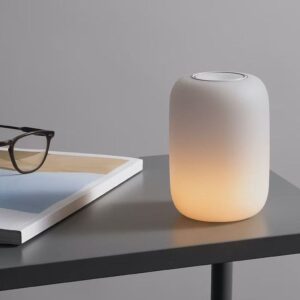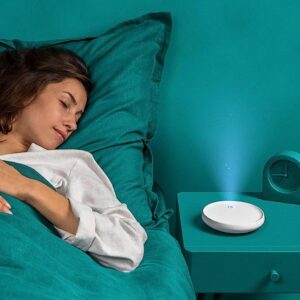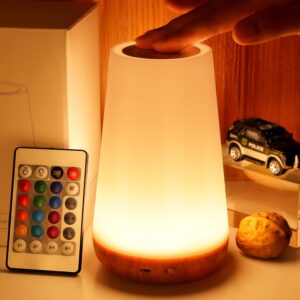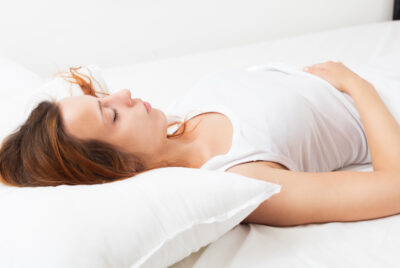Sleep Lamp: Your Guide to Better Night’s Rest
In today’s fast-paced world, sleep is becoming a luxury for many. In this situation, sleep lamps have become a beacon of hope for those seeking a restful night. These are no ordinary bedside lamps. They are carefully designed to suit the natural cycle of sleep and wakefulness and offer more than just illumination. As the name suggests, sleep lamps are specifically tailored to improve the quality of sleep and provide a peaceful atmosphere that invites restful slumber. Read more about “Sleep Lamp: Your Guide to a Better Night’s Rest”
Their effectiveness is evidenced by their growing popularity. With the growing awareness of the importance of sleep for overall well-being, people are actively seeking solutions to combat sleep disorders. With their soft glow and scientifically backed benefits, sleep lamps have become a popular choice for many households.
History of Sleep Lamps
The intertwining of light and sleep isn’t a new concept. Ancient civilizations, without the distractions of modern technology, relied heavily on the sun’s natural cycle to dictate their sleep patterns. They woke up to the sun’s first rays and retired to their abodes as darkness enveloped the land. However, as societies evolved and artificial lighting came into existence, our sleep patterns witnessed a significant shift.
Recognizing the need to mimic nature to improve sleep, innovators began experimenting with different light intensities and colors. This led to the birth of the sleep lamp. Over the decades, these lamps have undergone numerous refinements, with modern versions boasting features like adjustable brightness, timers, and even connectivity to smart devices.
Why Choose a Sleep Lamp?
The allure of sleep lamps goes beyond their aesthetic appeal. At their core, they serve a functional purpose, addressing the common sleep challenges many face. In an environment riddled with distractions, from the blue light of screens to the hum of electronics, achieving uninterrupted sleep can seem like a distant dream. This is where sleep lamps step in. Their gentle, non-intrusive light provides the perfect backdrop for relaxation.
Moreover, sleep lamps are versatile. They’re suitable for individuals across all age groups, from restless toddlers to adults battling insomnia. The controlled light environment they offer aids in the production of melatonin, the sleep hormone, ensuring a natural transition into sleep. For those skeptical about introducing another gadget into their sleep environment, rest assured, the sleep lamp is more of a sleep aid than a gadget.
The Science Behind Sleep Lamps
Our bodies operate on an internal clock known as the circadian rhythm. This rhythm is heavily influenced by light exposure. During the day, exposure to bright light keeps us alert and active. As night approaches, the diminishing light signals the body to produce melatonin, preparing us for sleep. Sleep lamps are designed keeping this very principle in mind.
By emitting a soft, warm glow, these lamps replicate the conditions of dusk, priming the body for sleep. The absence of blue light, which is known to hinder melatonin production, ensures that the body’s natural sleep-wake cycle isn’t disrupted. Furthermore, the rhythmic pattern of certain sleep lamps, mimicking the ebb and flow of natural light, provides an added layer of relaxation, gently lulling users into a deep, restorative sleep.
Benefits of Using a Sleep Lamp
- Improved Sleep Quality: The gentle illumination from sleep lamps promotes the production of melatonin, the sleep hormone, leading to deeper and more restful sleep.
- Mood Enhancement: The soft glow can create a calming ambiance, reducing stress and anxiety levels, which in turn can uplift one’s mood.
- Reduced Blue Light Exposure: Unlike smartphones and other electronic devices, sleep lamps don’t emit blue light, which can interfere with the sleep-wake cycle.
- Energy Efficiency: Many modern sleep lamps use LED technology, which consumes less power, making them energy-efficient and eco-friendly.
- Versatility: Beyond just aiding sleep, these lamps can serve as reading lights, nightlights, or even mood lights for meditation and relaxation sessions.
- Natural Wake-Up: Some advanced sleep lamps gradually increase in brightness, mimicking the sunrise, providing a more natural and gentle wake-up call than abrupt alarms.
- Safety: For individuals who need to get up during the night, a sleep lamp provides just enough light to navigate without being jarringly bright.
- Customizable Settings: Many sleep lamps come with adjustable brightness levels and color settings, allowing users to tailor the light according to their preferences.
- Compact and Portable: Their sleek designs make them easy to move, perfect for travelers or those who want to maintain their sleep routine wherever they go.
- Cost-Effective: In the long run, investing in a sleep lamp can be more cost-effective than constantly buying sleep aids or medications.
Popular Sleep Lamp Products
1. Glow Light
- Description: A modern, ambient light designed to mimic the natural glow of a sunset, enhancing your sleep environment.
- Advantages: Provides a calming atmosphere, energy-efficient, and adjustable brightness settings.
- Basic Parameters: LED technology, 10-100 lumens, 2700K color temperature.

2. Dodow – Sleep Aid Device
- Description: A revolutionary device that uses light metronome technology to guide breathing and induce sleepiness.
- Advantages: Natural sleep aid, suitable for insomnia sufferers, and easy-to-use touch-sensitive surface.
- Basic Parameters: Battery-operated, 8-minute and 20-minute sleep cycle settings, blue LED light.

3. AMEXI Touch Lamp
- Description: A versatile touch lamp with multiple color options, doubling as a night light and ambient room light.
- Advantages: Touch-sensitive controls, energy-saving LED technology, and a variety of mood-setting colors.
- Basic Parameters: LED bulb, 3W power consumption, 120V voltage, RGB color spectrum.

Technical Specifications to Consider
- Light Intensity (Lumens): The brightness of the lamp. Higher lumens mean a brighter light, while lower lumens offer a dimmer light.
- Color Temperature (Kelvin): This determines the warmth or coolness of the light. Lower Kelvin values produce a warmer, amber light, while higher values result in a cooler, bluish light.
- Adjustable Brightness: The ability to adjust the light intensity to your preference, often with a dimmer switch or touch controls.
- Timer Function: Allows you to set a specific duration for the lamp to stay on, after which it will automatically turn off.
- Power Source: Whether the lamp is battery-operated, rechargeable, or needs to be plugged into an electrical outlet.
- LED Lifespan: The estimated number of hours the LED light will last before it needs replacement.
- Material: What the lamp is made of, such as plastic, metal, or wood, which can affect its durability and aesthetics.
- Size and Dimensions: The physical size of the lamp, ensuring it fits well in your intended space.
- Weight: Especially important if you plan to move the lamp around frequently.
- Connectivity: Some modern sleep lamps come with Bluetooth or Wi-Fi capabilities, allowing you to control them via a smartphone app.
- Sound Features: Some sleep lamps may also include white noise or nature sound options to further enhance the sleep environment.
- Energy Efficiency: How much electricity the lamp consumes, which can impact your energy bills and carbon footprint.
- Safety Features: Such as automatic shut-off when the lamp overheats or gets tipped over.
Sleep Lamp vs. Traditional Lamps
Sleep lamps are specifically designed to aid in the sleep process, offering features that traditional lamps typically don’t. Unlike the stark brightness of conventional lamps, sleep lamps provide a softer, more ambient glow, which is conducive to relaxation and sleep. The color temperature of sleep lamps is also tailored to promote sleep, often with warmer hues that don’t interfere with melatonin production. On the other hand, traditional lamps are more for illumination purposes, be it for reading, working, or general room lighting. They might not have the features that specifically cater to sleep and relaxation, making sleep lamps a more specialized tool for those looking to improve their sleep environment.
Safety Precautions
When using a sleep lamp, it’s essential to ensure it’s placed on a stable surface to prevent any accidental falls. If the lamp uses a bulb, ensure it’s the correct wattage to avoid overheating. For sleep lamps with electrical cords, regularly check for any wear and tear to prevent potential electrical hazards. It’s also advisable to keep the lamp out of reach of young children and pets. For those with light sensitivities or specific medical conditions, it’s best to consult with a healthcare professional before integrating a sleep lamp into their routine.
Maintenance and Care
Taking care of your sleep lamp will prolong its lifespan and ensure it functions optimally. Regularly dust the lamp to prevent any buildup, which can affect its brightness. If your lamp has a removable cover or shade, occasionally wash or wipe it down according to the manufacturer’s instructions. For lamps with LED lights, there’s minimal maintenance required, but for those using bulbs, ensure you replace them as needed. Always unplug the lamp before cleaning or replacing parts to ensure safety.
Environmental and Sustainability Aspects
Modern sleep lamps, especially those using LED technology, are more energy-efficient than traditional incandescent bulbs. This not only reduces electricity consumption but also minimizes carbon footprint. Furthermore, many sleep lamp manufacturers are now using sustainable materials and adopting eco-friendly production practices. When choosing a sleep lamp, it’s worth looking into its energy consumption, the longevity of its light source, and the sustainability of its materials to make an environmentally conscious choice.
Who Should Consider Buying a Sleep Lamp?
Anyone looking to enhance their sleep environment can benefit from a sleep lamp. This includes individuals with sleep disorders, frequent travelers who want to create a consistent sleep setting wherever they go, or even those who simply enjoy a calming ambiance before bedtime. Parents of young children might also find sleep lamps beneficial in creating a soothing environment for bedtime routines. Additionally, those living in urban settings where there’s significant light pollution can use sleep lamps to counteract the effects of external lighting.
Conclusion: Making the Right Choice
Investing in a sleep lamp can be a game-changer for many, offering numerous benefits that go beyond just illumination. When choosing the right sleep lamp, consider your specific needs, the features offered, and the lamp’s environmental impact. With the myriad of options available today, you’re sure to find a sleep lamp that not only enhances your sleep quality but also complements your living space beautifully. Remember, a good night’s sleep is crucial for overall well-being, and the right sleep environment can make all the difference.
FAQs
How long should I use the sleep lamp each night?
It varies, but generally, 30 minutes before bedtime is recommended.
Can I use a sleep lamp for my children?
Yes, but ensure it’s placed out of reach and check for child-friendly features.
Is there any risk associated with using a sleep lamp?
Generally, no. But always follow the manufacturer’s guidelines.
How often should I replace the bulb?
It depends on usage and the lamp model. Check the product manual.
Can I travel with my sleep lamp?
Most are compact and travel-friendly, but always pack it securely.




